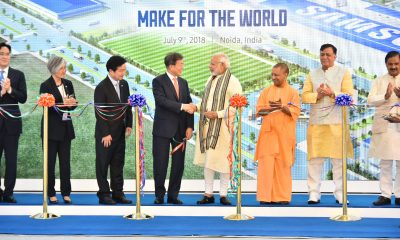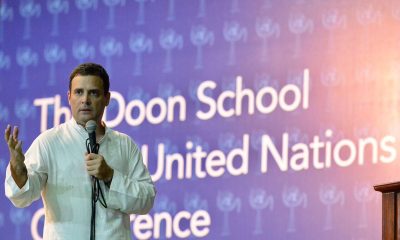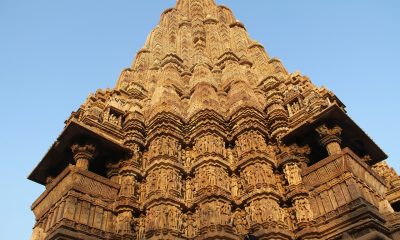India
Higher Education Under Attack From 10 Janpath
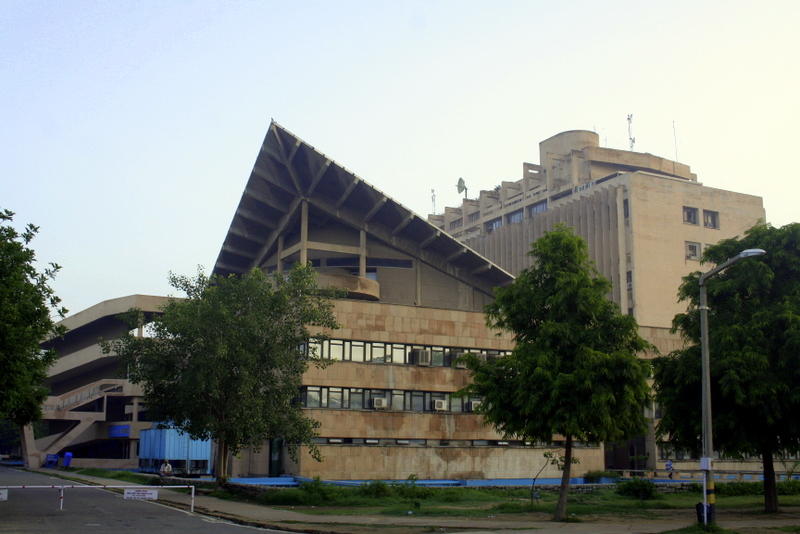
IIT Delhi, photo by flickr/ramesh_lalwani
While opinions vary on the performance of the first Indian governments in different sectors, higher education is a sector where India’s first steps usually evoke a positive response across the board. One can clearly see the success of secular advanced education that has paid dividends in India in a strong contrast to the other countries of the Indian subcontinent where either higher education was not given enough emphasis or was not secular in its character. Do not get me wrong, higher education in India has clearly not been an all-sunshine story, as India is far from its true potential but what I am trying to emphasize is that it is not a complete failure yet. You will get to see that ‘as yet’ is the operational word, as we are soon heading down the lane of Pakistan and Afghanistan, courtesy of the dirty politics of New Delhi.
Even though initial seeds of education were sowed with a foresight of modern secular thinking, Indian academia has failed to truly blossom. The reasons for this are manifold. We certainly need to explore all the reasons for the Indian failure to launch but right now the call of the hour is to protect the barely-alive academia from the ongoing onslaught of the myopic, vindictive and dictatorial UPA regime that is hell bent on destroying secular character of our advanced education system. When we get beyond fending the attacks from Kapil Sibbal and other cronies of 10 Janpath, then we must ask despite having one of the highest density of researchers and research settings in many sectors, why India frequently fails to innovate.
If we want to lift the standing of Indian education, then we need a cold blooded, comprehensive evaluation of the rotten cesspool of shit that Indian research set up of science and humanities alike, is quickly degenerating into. Instead of a lengthy voluminous and systematic evaluation of all the facets, in this article, I will present few case studies of attack on the secular character of higher education to pique your interest and foment direct action. Hopefully once you see the preventable rot, we will together be part of this battle with 10 Janpath and the puppet prime minister to improve education and research that can enable India to better deal with economic, social, medical and technical problems and most importantly evolve an intellectual culture that cannot be measured in terms of any price tag.
Indian policy makers under Nehru paved the way for a secular scientific higher education by establishing central and state universities, technical colleges and research institutions and attracting exceptional talent to run what used to be somewhat autonomous academia. Here I am focusing on 10 Janpath attacks on central universities alone instead of research institutions and technical colleges. Central universities educate more students and employ more researchers than the research institutions and technical colleges. These central universities are now facing a threat to their secular and modern character due to opportunistic politics and rise of religious fundamentalism.
Let us take the example of the University of Delhi, one of the largest of the central government universities that once used to be projected as a pride of India. It is now suffering from the same structure that initially served it well. The University is structured such that power is in the hands of few people who are politically appointed, instead of entirely merit-based autonomous council that is outside the influence of politicians. The University of Delhi has a Visitor who in theory has the ultimate power. This Visitor is the President of India. Then comes the Chancellor, who is the Vice President of India. The president of India on the advice (but in reality on the dictates) of the office of the Prime minister and the ministry of Human Resource Development appoints the Vice-Chancellor. The Vice Chancellor (VC) is in effect the head of the University. The VC can act like the dictator of the University, if he or she wants to, with obviously no reporting to the constitutional namesake head of India – the President. The VC appoints his team that plays a role in deciding the allocation of resources, approval of course work, appointment of college principals, teachers and eventually all policy matters. Although certain academic bodies involved in decision-making, like the executive and academic council have some elected members, usually no member gets elected without a political affiliation and backing.
This structure is in a strong contrast to the free merit-based truly autonomous academia in the developed parts of the world. The reason this structure worked to some extent in the first few decades after independence is that educated ruling class understood that academia should be run mostly on merit if the nation has to prosper. Unfortunately, the structure that was evolved depended on the wisdom of the Prime Minister but not a structure that was free from political intervention. This structure although constitutionally has some balances and checks in the form of some elected members in the administrative bodies and vibrant trade unions but to overcome this menace of democracy, Kapil Sibbal’s men have decided not to call any meetings of these bodies and rule by decrees. With Sibbal’s blessing, these men have forced academics to knock the doors of court on every matter if they do not like their dictatorial and inane decisions.
We all know of the always honest, political intervention free and super-expedient Indian judiciary. You judge what the outcome of such policy is going to be. Vice Chancellor at times has delayed calling due meetings of these administrative bodies for over a year on many vital decisions. The situation is so bad that even if an elected member in these bodies is a card holding Congressi, given his or her answerability to the faculty, even that member to maintain credibility, ends up opposing the Vice Chancellor. From students point of view one needs to look at directly impacts courses and degrees and what influences the quality and job satisfaction of the educators. One should wonder the wisdom of haphazardly changing the curriculum, introducing semester system without understanding logistics, pros and cons, whimsical twists to examination patterns, attendance policies that destroy precious years of young students and alter their career paths midway. We should systematically explore the various criminal actions of VC, various deans and heads of departments against educators, like blocking their promotion, holding back pension money and encouraging harassment of dissidents to score political points. In any advanced country with a rule of law, this kind dictatorial and incompetent conduct would get the criminals, not just the cronies but central government ministers and the ultimate puppet masters behind bars for decades. Only in countries where people with fake degrees and false claims of ties can set education agenda to Harvard and Cambridge that the business goes on as usual despite the ongoing rape of education and motherland in general.
I would like to remind you that the decision-making bodies like academic and executive council are infested with non-elected members appointed by dictates of 10 Janpath and those elected are almost always affiliated with political alliances like the UPA, NDA or the left groups. The party in power at the centre with all its economic muscle and influence favours the election of its sympathetic candidates to these bodies. This is just an insult to the injury, given that there should be no role of one’s personal political leanings in academia, leave alone using it as a ground for dirty political games. Given the direct influence of the Vice chancellor in the appointment of college faculty through his appointed members in the interview panels and indirect influence through college principals, the system is designed such that rarely can a new teacher unfavourable to 10 Janpath be offered a position, whatever be their merit.
Even though the system is rigged from the start, still at rare instances, exceedingly good merit prevails and sadly, for Sibbal, time travel has yet not been invented to remove the old academically meritorious and honest crop. The way this academically honest section of faculty has been attacked is by exemplary punishments ranging from everyday discrimination to blocking promotions, derecognizing existing promotions, blocking salaries and pension money. Instead of directly hearing grievances for even most serious matters, the Vice Chancellor appoints someone on his behalf for representation. This representation is not acknowledged in writing and minutes of meetings are never provided to the complainant to evade any legal action. Though such attacks have been on people with saffron background too, these attacks have been more focused on people with secular credentials, as these people would not let Sibbal use academia as place for communal electoral politics. Politicians are now using vote bank politics of appeasing fundamentalist demands of different communities and keeping Indian society divided from the stage of once sacrosanct academic settings. A recent look at sub judice cases on Indian academic giants will open eyes of anyone wanting to see the carnage by the bulldogs of 10 Janpath to enforce their corrupt dictatorial agenda. I would clarify that my refrain is not in any way to honour the farcical judicial system but I do not want the victims of Sibbal to face additional pressure. After years of research in US, I spent one year (2011) in India to explore the current scientific and socioeconomic landscape of my home country and witnessed carnage of Sibbal and corruption of academia up close. While I am keeping detailed account of this experience for later, I would briefly like to point to the fact that corruption of academic culture enables significant portion of research to be plagiarized in India and original research to be below par – reminding me of a Samuel Johnson witticism “Your manuscript is both good and original. But the part that is good is not original, and the part that is original is not good.” This open politicization of education enables funding grants for non-existing research, denial of positions and funding to deserving candidates, existence of redundant institutions with zero productivity, harassment of researchers, violations of basic ethical codes of conduct, including the use of research facilities and funds for personal benefits, open solicitations in a supposedly blind peer review system.
If one is looking for obvious examples of this corruption, one can see a blatant hiring scam in the recruitment of several new teachers in some of the new colleges of the Delhi University. In a central university, everyone is supposed to be paid by the University Grant Commission (UGC); now many teacher appointments within the University of Delhi are illegally paid from the chauffeurs of the state of Delhi. This constitutional breach of pay check coming from state budget for a central university in its most optimistic scenario reeks of lack of any planning by the incompetent men and at its worst and more likely scenario, a tool to change demographic to less competent but more sympathetic to 10 Janpath. A simple look at the recent appointments of college Principals can show you the infestation of Indian academia by Congress honchos. For some merely accidental reasons (pun intended), an overwhelming number of recent College Principal appointments seem to be of young Punjabi female teachers who once used to teach science and are strongly affiliated with Yuvraj Rahul’s gang.
I have nothing against young age, being a young scientist myself, neither against women, for whose rights, I have been fighting for all my adult life and nothing against Punjabis, which is my paternal ethnic heritage but I cannot stand having any other criteria than merit to decide the future of our country. What sense does it make to appoint a science faculty as Principal to a college with only humanities subjects, unless it is for simple political reasons? From over a decade ago, before I moved to top Indian research institution and then to top US research facilities, when I was young undergraduate student at this same university, I knew a very incompetent teacher who used to knit sweaters in our classroom, while reading textbooks verbatim. Her acts and intelligence could have made middle school teacher look Aristotle or Socrates in comparison, though she did order free tea for us in cold December months. In sympathy with other women, she frequently advised my female classmates against pursuing a postgraduate degree telling of non-academic compromises it took for her to get a Ph.D. The last I heard from her is when she became a Principal of a new college under this new administration because of proximity to Indian National Congress.
Sitting in a U.S. research institution that has produced one of the most numbers of Nobel laureates in the field of Medicine; I have no problem pointing out some individuals in India. Nevertheless, pointing few such examples would not solve much and it would be unfair for only one or two incompetent political puppets to be recalled due to my finger pointing while the epithet of corruption remaining the same. So, I will leave pointing lower level individuals for some later stage, just giving them chills for now but focus on Rahul baba, puppet prime minister, corrupt ministers and VCs ruining our education.
Few years ago at the University of Delhi, a collusion of BJP and Congress’s political interests, led to a laughable act of allowing astrology (no, not astronomy but dumb stone age astrology) to be part of its curriculum. After much of controversy and worldwide ridicule acclaimed intellectuals, it was eventually withdrawn. One may wonder that after such infamy the government would not redo such mistake again but alas. The trend of non-secular intervention continues unabated. Somehow magically fundamentalist administrators, be it a Muslim, Sikh, Christian or Hindu whosoever suits Congress’s electoral play continues being appointed. Some of the ethnically focused institutions, whether for segments within minorities or majorities were created to encourage enrolment of students from segments who otherwise faced the danger of being left out without such privileged institutions. The goal was to create a modern alternative to inadequate and often sectarian madarasa or ashram kind of religious education that these youngsters might be turned to in absence of secure modern alternatives. To provide such education faculty from all ethnicities were hired and promoted. Now with politicization, somehow the faculty enrolment has started paralleling the bias in student enrolment, throwing the criteria of merit of faculty in the dirty ditch of politics. Such bias denies good quality education to target segments that these institutions were in the first place set up to provide for.
While a trip around the University of Delhi would bear out many such examples of decadence of this administration, I would like to point out a single notable piece of capitulation to religious fundamentalism so you can better see how appeasement of different ethnic group works for political convenience. Recently based on orders from Congress headquarters, the Vice Chancellor forced the University to withdraw ‘Three Hundred Ramayans’, a great text by AK Ramanujan that quite clearly captures the ubiquitous nature of Ramayana tales in the whole of Indosphere, even beyond Indian subcontinent like in the islands of Indonesia or lands as distant as Cambodia. The text educates to the fact that Ramayana has many local variants and it is a truly a tale of all Indic region with amazingly deep cultural penetration that has sway in shaping even an atheist like me, leave alone some orthodox Vaishnav Hindu. After saffron politicians stroke trouble objecting to this long-standing course material the talibanized RSS goons of Akhil Bhartiya Vidyarthi Parishad (ABVP), the student wing of BJP got offended to this whiff of knowledge. Their argument (or more accurately non-argument) was that Valmiki Ramayana is the accurate one. The claim that one version of Ramayana is celebrated more is correct, especially when viewed with strictly North Indian Vaishnav lenses but the argument is ridiculous, as the material was not taught as a course on religion. This text was not an effort to say one version is right or wrong or which imaginary fried should one believe in or which organize religion is better, but a historical collection of different texts that exist in the Indosphere.
Five exemplary texts that captured the largest heterogeneity were chosen to capture the diversity of cultural heritage. Congress did not want to lose Hindu fundamentalist votes to BJP, so to one up the idiots of sangh, Sibbal decided to use his bully pulpit to remove the text from the course work all together. This move, where history and literatures appropriateness is decided by the sentimentality of ill-educated political goons instead of facts, is no different than banning some book because of a fatwa by some crazy Mullah in streets of Lahore, Riyadh or Kabul. Such yielding to pressure from religious bigots in general public life of India is not new and not even unique to Delhi’s Congress-BJP dominated politics. Who can forget unsympathetic treatment meted out to Taslima Nasreen by the stalwarts of left, the so-called secularists? What is new is the systematic attack on academic integrity by a demon of religious fundamentalism, corruption and dictatorship that is unleashed by Sibbal on the commands from 10 Janpath. This removal of highly acclaimed assay is being condemned worldwide and such acts continue to degrade the legitimacy of Indian education and validity of higher academic degrees.
More than the damage to Indian image or to the validity of Indian educational credentials, the impact from such acts, if recurrent, will render an already barren Indian innovation and academic landscape to become completely sterile. A healthy academic culture, where one can discuss life stories surrounding the myth and reality of lives of Prophet Mohammad, Guru Nanak, Jesus Christ or Lord Rama, when in the context of history or of linguistic style, independent from the sentimentality of religion or conduct research on the impact of a particular pesticide on human health, independent of the connections of that pesticide company to the ruling party, is a necessary backbone of any country aspiring to innovate and grow. I am actually not much of a Nehru fan on most socioeconomic and defence issues but what I think was his singular undisputed legacy of sowing the seeds of higher education is now being destroyed by his own great grandson.
I also want this article to serve as warning that if the state of affairs of Indian academia gets worse than international condemnations, signature by top academics including Nobel laureates, boycotts and derecognizing several academic degrees would have to initiated to stop this rot of academia in India. Such actions to improve India would not be unprecedented for Indian expatriates. Recently, to stop the murder of the rule of law by Indian judiciary that was allowing indefinite detention of people without evidence, the international community including many notable Indian expatriates jumped into action, shaming India at the world stage. This external ridicule and pressurization is the least pleasant and most painful thing an Indian can do but when reform does not come from within then one is not left with any other option. One may be aware of the fact that many degrees from India are not recognized internationally and the list is not shrinking. If this corrupt management run by Sibbal’s cronies continues ruining the quality of graduate and postgraduate education and stifles the intellectual output then whether one likes it or not, several other Indian academic honours, intellectual exchange programs will almost justifiably face an international axe. While there shall soon be action from international intellectual community if the victimization of secular teachers and Talibanization of education continues but what is truly needed in India is an internal change. No international pressure, punishment or encouragement can drag India to the modern era. Only Indians living in India can do so. The sleeping elephant has to wake up on its own, assuming the elephant is sleeping and not comatose or cold dead. It is unlikely that academic causes on their own would generate equal anger as has the corruption on street but all versions of Ramayana teach us that all sins add up. This murder of intellectual culture of central universities may provide additional fuel to the funeral pyre being readied for the political class if change does not come soon.
India
Government Changing Syllabus to Include Sikh History in India
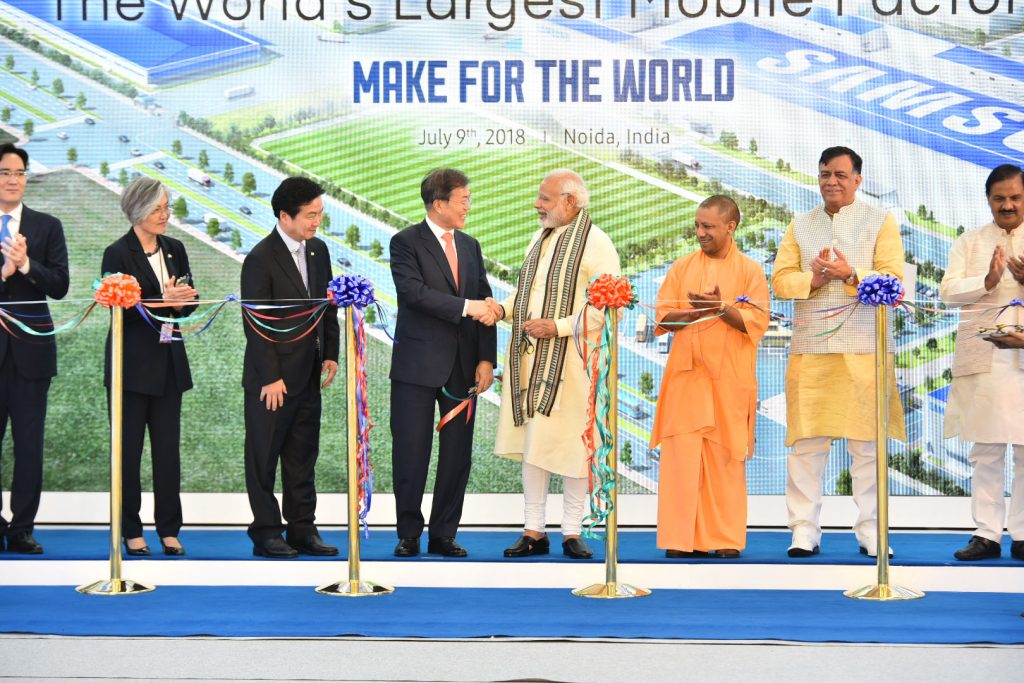
Chief Minister of Uttar Pradesh, most populous state in India, has announced inclusion of Sikh history in the state syllabus. Students of all schools under UP State Board will see the new chapters. The announcement came when Chief Minister Yogi Adityanath (BJP) was observing Sahibzada Diwas.
Why do we Observe Sahibzada Diwas?
Sahibzada Diwas marks the martyrdom of four ‘sahibzada’ (or sons) of Guru Gobind Singh (10th Sikh Guru) and his mother Mata Gujri. In the year 1705, Mughal Emperor Aurangzeb had ordered torturing of youngest sons of Guru Gobind Singh aged 5 and 8. He later executed the little sons by burying them alive into a wall. The reason for this act was that they refused to convert to Islam. Soon after this event Guru Gobind Singh’s mother, Mata Gujri also martyred her life under Aurangzeb’s captivity. The cause of her death is still unclear. Guru Gobind Singh’s other two sons martyred their life in the Battle of Chamkaur Sahib. Thus the 10th Sikh Guru, Guru Gobind Singh had lost his whole family by 27th December. This is an important event in the Sikh history in India and UP Government is finally keen on observing Sahibzada Diwas every year.
Why UP Government is Changing the Syllabus?
Soon after the independence of India in 1947, the school education came under tight grip of far left and communists. Most of the Indian history in the recent past has been written by Romila Thapar and Irfan Habib. They have close ties with left wing ideology and Irfan Habib has delcared himself as Marxist. They wrote history text books by either phasing out sections of Indian history or diluting certain events. The motivation to soft alter the history has been to propagate left-wing/communist ideology. Historian Koenraad Elst once highlighted that Romila Thapar is comfortable neither in Sanskrit nor in Farsi language. The knowledge of these two languages is a must to understand India’s history.
In the recent years, various public opinions have gained momentum to rewrite Indian text books to include more content on Indian rulers and native ideas. Currently, Indian text books mainly teaches about foreign rulers of India such as Mughals and British.
With this announcement of inclusion of Sikh history in history text books, the government is bringing historical facts in mainstream.
27th December as Real Children’s Day
Chief Minister Yogi Adityanath has also reached out to the Education Minister to declare Sahibzada Diwas as Children’s day. He further added that “The history of Sikh gurus will be a part of the syllabus. Apart from this, we should observe December 27 every year as Sahibzada Diwas in all schools. Today is the day to pay gratitude to the sons of the Guru and mother who martyred their lives for the motherland, country and religion.” Yogi Adityanath also said that “No society can move ahead if it forgets history. The Sikh society is known for its hard work. The Sikh gurus sacrificed their lives to defend the Hindu religion. The country will always remember this.”
Yogi Adityanath added that learning about the sacrifices by Sikh Gurus would inspire future generations to dedicate themselves into nation-building. He emphasized that we should make future generations realize that India and Indian culture was safe because of sacrifices of Sikhs.
What Should We Do On Sahibzada Diwas?
Sahibzada Diwas should be an important day for every Indian regardless of their region, culture or religion. On this day, we are in the Holiday mood as it falls right between Christmas and New Year’s eve. However, we should remember that a Guru and his entire family sacrificed their life for the well being of India and the idea of India.
On this day we can fast, do sewa (service), visit a nearby Gurudwara and sleep on the floor at night.
China
Nepal Hindu Rashtra: Time to Wrap Up Communism?
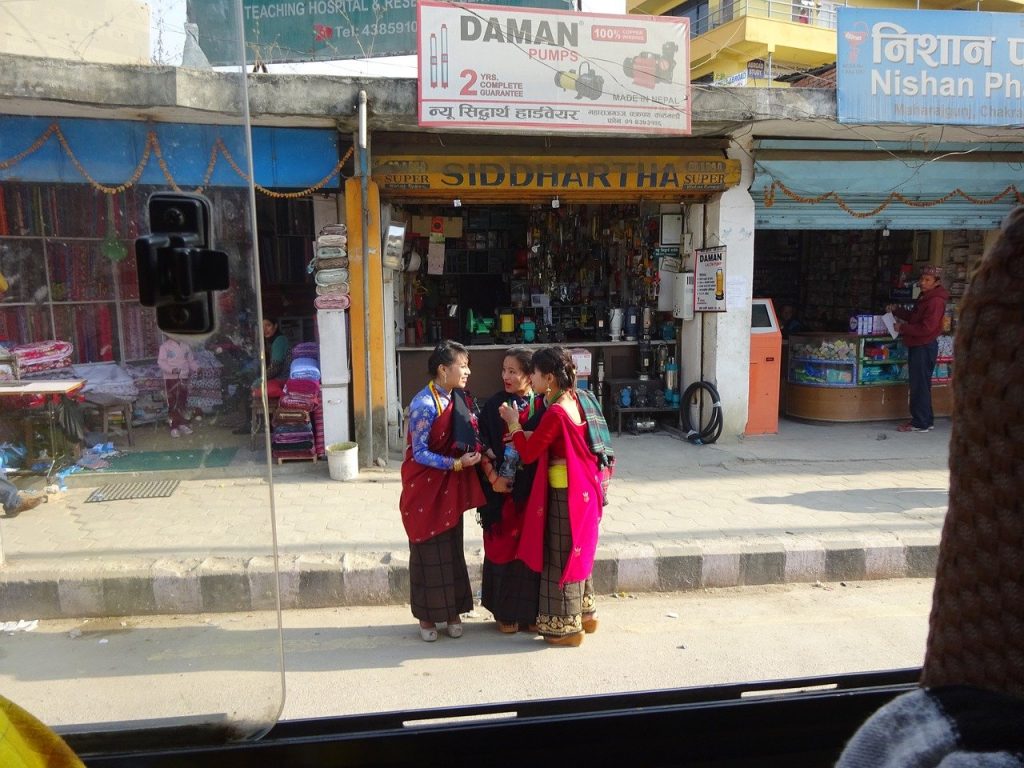
Nepal abolished the Constitutional Monarchy in May 2008 and declared itself as a Federal Democratic Republic. There was a new hope in Nepal as it was becoming world’s newest democracy even though it had dissolved the Hindu Rashtra. However, the democracy in Nepal immediately got into the tight grips of leftists and communists backed by China. It has been almost 12 years since monarchy was abolished in Nepal. Interestingly, the Himalayan country has already seen 11 Prime Ministers in this period. Thus, leaving the Nepalese people still yearning for good and stable governance.
Re-establish Hindu Rashtra
As the political instability is growing in Nepal, people are demonstrating concerns about the future of the country. In fact, Nepalese citizens are unhappy with frequent interference by China and India influencing its unstable communist regime. More voices are now growing in support of reinstating the Monarchy and declaring Nepal as world’s only Hindu Rashtra (which by default offers full religious freedom to other religious minorities as per Hindutva concept of Sarva Dharma Sama Bhava – all paths lead to one).
Former Deputy Prime Minister of Nepal, Kamal Thapa said that if political parties do not recognize the seriousness of reinstating the monarchy, then the country will head for a period of darkness. “Recently, we’ve had high-ranking officials from India and China come to Nepal to try and solve problems within the ruling party,” he said. “We cannot let others dictate what we want to do.”
Communist Party All Set to Suppress Protests, By Force
Kamal Thapa has firmly demanded an all party meet to discuss reinstating of monarchy. Throughout the month of December, 2020 Nepal has seen anti communism protests across the country in support of reinstating the monarchy and Hindu Rashtra. Most importantly, the demand has become a nationwide mass people’s movement. So much so that the communist regime had to send a directive to 77 districts in 7 provinces. The directive suggests suppressing the protests by force. Nevertheless, Rashtriya Prajatantra Party and other royalist groups have ignored this threat from the communist regime. Protester groups have pledged to strengthen the protest in the coming weeks.
Nepal: Demonstration held in capital Kathmandu, demanding restoration of monarchy in the country. pic.twitter.com/TFjmKu9U9Z
— ANI (@ANI) December 5, 2020
Role of China – Hope for Communism in Nepal
China’s ambassador to Nepal is known to have very close relationship with Nepalese Communist regime. In fact, She has been super effective in tilting Nepal’s posture towards its ideological partner, China. One of her greatest achievements in 2020 was artificially manufacturing a border conflict between Nepal and India. Consequently, souring relations between the two Hindu majority nations. In addition, she managed to silence Nepal’s communist government after China took one of Nepal’s border villages under its control. However, recent political turmoil in Nepal and a renewed demand for reinstating of Hindu Monarchy is showing that the situation is now out of Chinese hands
Role of India
Year 2020, was not a good year for India and Nepal relations. India was busy in controlling domestic Covid cases. On the other hand, China had launched an invasive campaign into Indian territory. In addition, India is always busy with Pakistan on its western borders. However, the surprise came to India when China was almost successful in creating a new border tension between India and Nepal.
Those who do not know about Indian government should note that the current ruling party in India finds itself ideologically opposite to communism. This further creates differences between the two countries.
Communist party in Nepal has blamed India for supporting the ongoing anti communism protests in Nepal. However, former advisor to Nepal’s PM has suggested there is no proof that India is fueling pro Monarchy, anti communism demand in Nepal.
Nevertheless, There are certain influencers in India who have, in their personal capacity, expressed support for reinstating the Hindu monarchy. Yogi Adityanath, who is the Chief Minister of an Indian state bordering Nepal, said in 2015 that Nepal should declare itself a Hindu Monarchy. Readers should note that in 2015 Yogi Adityanath was not the Chief Minister yet. However, today he is not only popular in south of Nepal, his popularity is growing in Nepal as well.
Will The World See the first Hindu Rashtra?
It is difficult to answer this question at this moment. However, Nepalese communist government could not resolve the political instability and in December 2020 Nepalese government dissolved the parliament. Nepal will see next elections in April – May 2021. Hopefully, the world will see Nepal’s 12th Prime Minister in 13 years or may be a Hindu King? Royalists and protester groups have expressed confidence in winning next elections. We have our eyes on Nepal for updates.
India
Humanity Endures During Coronavirus Pandemic

Photo by Press Information Bureau, Government of India
The world changed exponentially since the pandemic broke out. We changed too. Emotions are running high. We have learnt to take one day at a time and have stopped expecting changes to happen overnight.
“COVID19 is menacing the whole of humanity – and so the whole of humanity must fight back”
A clarion call from United Nations Secretary-General António Guterres is a call to unity and solidarity. Already plagued by natural/manmade disasters and wars, many countries seem to bite the dust for want of resources in the fight against the virus. Warning each other against complacency is appreciable but never a blame game to cover up a dysfunctional response. Not all update themselves on the governments, new economic policies and R&D on Covid vaccine. Many we come across seem to be making wise individual choices. No matter how badly the tiers of government fail us, there will always be thousands of people working to make things better. Besides, finding reasons and faults on policies for the spread doesn’t help. A virulent strain of flu had managed to spread within a few months to the remotest corners of the world infecting half a billion people – more than a quarter of the human species in 1918 long before the current age of globalization.
Separating, alienating and forswearing the endless moments of contact that knit society together thrust us into frightening new realities. The good is still there. Social distancing is nothing but taking a step back to literally give breathing space to others. Going by news & views, we understand that amid concerns of rising numbers of positive cases in frustrating circumstances, acts of kindness and solidarity are burgeoning. Yes, it’s been extremely sad and sobering to watch this all unfold, but watching people share resources and supporting one another in every conceivable way has made us feel more connected to our local communities. Whether singing a song together out on balconies, getting groceries for the elderly or calling a friend to alleviate anxiety and fear, each one I know play a part and take comfort in a sense of togetherness. We are steadily aware of our limitations yet don’t hesitate to free our wells of compassion. Do we think twice and thrice to make an online contribution to save the lives of people we don’t know and will never know!
Sadly, it has taken an invisible virus to help us belive once again that we are strongest only when we have the welfare of others in our mind. Halfway through quarantine and self-isolation a phone call, a kind word, an opportunity to reach out, a breeze, bird calls, one good news and loss of a loved one, we are hit with the necessary humility and awe we ought to feel and appreciate just how beautiful our world is and precious life is.
Post pandemic recovery will be better and bigger if life goes on with this beautiful idea, of humility, inwardness – as an ethical relationship, for the sake of others. For better or for worse, we have learnt that one can’t be an island unto himself. Lives are intertwined and are bound together. We, humans produce more rubbish than any other species. The growth in the human population is part of the explanation, but cannot account for all of the extra rubbish, a result of haste and greed both which almost skinned humans of humanity.
Unity among countries must ensure that all countries are equipped to trace, isolate and treat people infected by COVID-19. Only a global effort can avoid the collapse of any country’s medical system. Sanctions that affect health care should never be imposed. Development in one part of the world should not rob another country of it’s resources. Humanity gains the upper hand over invisible predators through the sharing of reliable scientific information, global solidarity, vaccinations, antibiotics, improved hygiene and a much better medical infrastructure. Today,it doesn’t take too much to figure out that global sharing and caring is the best defense. The Jing Si aphorism, “Good actions require everyone’s cooperation. So let’s not cling to personal biases” holds good for all times.
Stories of good samaritans are aplenty. To know humanity is still alive and kicking and is at it’s best when united assures us that we’ll come out of this “abnormal” time with a new normal. In their own unique ways, humans respond to protect life and health and ensure respect for fellow beings. ‘single-nucleotide polymorphisms’ are no joke. From handing over meals, survial kits, medicines, home made masks to calling on an old couple across the street, everything is humanity in action and it is the power of this humanity – humane behaviour towards other humans – that we seek to celebrate, improve and increase, especially during crucial times. Remember “A person with a generous heart and compassion for all beings leads the most blessed life”.
With thousands of migrant workers taking it on their chin, vehicles filled with food and ration along highways reach the needy and stranded and canteens serve free food. Rays of sunshine! We see through hypocrisy and deceptions, hear excuses for inefficiency, inadequacy and inflexibility and within the tumult and uncertainty we are doing much, much better in life than we thought we can. Quietly. Kindly. Gently. Being able to spare a part of us to help someone live is worth being thankful for. ” Giving with an expectation for return brings misery”. May we give generously, but don’t guilt ourselves if we can’t. If we have nothing left to spare, let’s go slow and kind.
The world is being taught a lesson, the harder way. This lesson is not about rich and powerful versus poor and powerless but about leadership that treasure the common wealth and common good, above private greed and profit and above protecting the privileges of a handful elites.
None of us are actually going anywhere. Might as well stay. The conclusion we draw from this crisis is that all humans matter equally, that we need to give a hand, raise one another, flourish or perish together- no matter what our limitations are, we’re capable of a great deal. This virus backlash is nothing short of a fleeting lesson to all leaders about how sane, humane societies should function all the time. Those who regard themselves as wonderfully favored of leadership, power and pelf are called to do great things. Anything that constantly arise to cause conflicts or disunion must be questioned, criticized, denounced and judged.
Be it a forced contemplation of our mortality or a sudden urge of self denial or an awareness of the passage of time and life, this screeching halt is proof that humans are designed to be more productive when connected, even in isolation. So, not all hope is lost. The time has come when we must know for ourselves why we believe in humanity as we do.
“Do something good for somebody today; the people who are trying to make the world worst aren’t taking days off.”
Gestures to honor humanity are varied, aplenty. A flypast in India is a cruel joke on the already tumbling down economy and on the selfless humanitarians who spare nothing to reach out. We can only wish the trail of showered petals, if showered will guide the departing victims of COVID19. Flying past/over ground realities is a highly irresponsible act of governments. Also, a misuse and mismanagement of meagre resources.
Was it a premonition that urged saint Thiruvalluvar, celebrated Tamil poet and philosopher to get on with kural 578 which when translated into English goes as
” The world is theirs (Kings) who are able to show kindness, without injury to their affairs, (administration of Justice).


